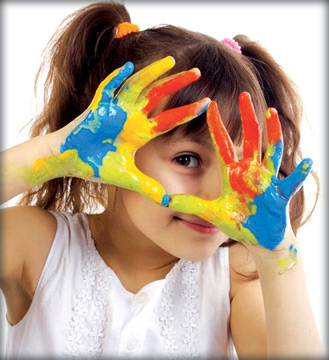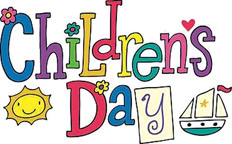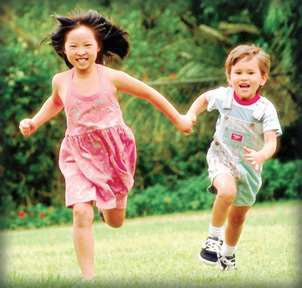|
Children’s and Elders Day 2014:
CHILDREN PORTRAY INNOCENCE AND PURITY
By Husna Inayathullah
|

Looking for amusement and details |
 “Children have never
been very good at listening to their elders, but they have never failed
to imitate them.” “Children have never
been very good at listening to their elders, but they have never failed
to imitate them.”
-
James A. Baldwin
Children and elders are innocent. They should be treated with love
and affection. Elders are the carriers of knowledge and experience.
Elders are first and foremost teachers and role models. They are vital
in the teaching process from infancy to adulthood.
Every child is regarded as a treasure. They make this world
beautiful. Children are so valuable. They are pure and innocent.
Children are said to be like wet cement, whatever falls on them makes an
impression. They are the future of a country and it is only by taking
care of them and guiding them on the correct path that discipline can be
instilled in a country.
In Sri Lanka, International Elders Day and Children’s Day are both
celebrated on October 1. The United Nations General Assembly voted to
establish October 1 as the International Day of Elders from October 1,
1991 on December 14, 1990.
Elders’ Day is celebrated by raising awareness about issues affecting
the elderly, such as senility and elder abuse. It is also a day to
appreciate the contributions that older people make to society.
Togetherness
The United Nations’ (UN) Universal Children’s Day was established in
1954. Universal Children’s Day is celebrated on November 20 each year to
promote international togetherness and awareness among children
worldwide. UNICEF, the United Nations Children’s Fund, promotes and
coordinates this special day, which also works towards improving
children’s welfare.
 Children’s Day is an event celebrated on various days in many places
around the world. International Children’s Day is celebrated on June 1
and Universal Children’s Day is on November 20. The International
Children’s Day had its origin in Turkey in 1920 and later in the World
Conference for the Well-being of Children in Geneva, Switzerland in
1925. Children’s Day is an event celebrated on various days in many places
around the world. International Children’s Day is celebrated on June 1
and Universal Children’s Day is on November 20. The International
Children’s Day had its origin in Turkey in 1920 and later in the World
Conference for the Well-being of Children in Geneva, Switzerland in
1925.
On December 14, 1954, the UN General Assembly recommended that all
countries should introduce an annual event from 1956 known as Universal
Children’s Day to encourage fraternity and understanding between
children all over the world and promoting the welfare of children. It
was recommended that individual countries should choose an appropriate
date for this occasion.
At the time, the UN General Assembly recommended that all countries
should establish a Children’s Day on an “appropriate” date. Many
countries respected this recommendation and the Universal Children’s Day
has since been annually observed on November 20.
On November 20, 1959, the UN General Assembly adopted the Declaration
of the Rights of the Child and on November 20, 1989, it adopted the
Convention on the Rights of the Child. Since 1990, Universal Children’s
Day also marks the anniversary of the date that the UN General Assembly
adopted both the declaration and the convention on children’s rights.
Universal Children’s Day is part of the work carried out by UNICEF,
the United Nations Children’s Fund. UNICEF’s logo consists of an image
of a mother and child, a globe, olive branches and the word “UNICEF”.
All parts of the logo are in UN’s blue color, although it may be
presented in white on a blue background.
Rights
Many schools and other educational institutions make a special effort
to inform children of their rights according to the Declaration of the
Rights of the Child and the Convention on the Rights of the Child.
Teachers stimulate their pupils to think about the differences between
themselves and others and explain the idea of “rights”. In countries
where the rights of children are generally well-respected, teachers may
draw attention to situations in countries where this is not the case.
  In some areas UNICEF holds events to draw particular attention to
children’s rights. These may be to stimulate interest in the media
around the world or to start nationwide campaigns, for instance on the
importance of immunisations or breastfeeding. In some areas UNICEF holds events to draw particular attention to
children’s rights. These may be to stimulate interest in the media
around the world or to start nationwide campaigns, for instance on the
importance of immunisations or breastfeeding.
Abuse takes place at home, in school, in institutions, at work, in
the community, in armed conflict and natural disasters. Much violence
against children, such as corporal punishment and sexual abuse, remains
legal and socially approved in many countries.
The violence children face takes many forms, such as exploitation and
abuse, trafficking, physical and humiliating punishment, harmful
traditional practices and recruitment into armed forces and groups.
Growing up with violence and abuse seriously affects a child’s
development, dignity, and physical and psychological integrity.
It is the responsibility of every single person to safeguard children
while taking care of the elders in society. |

